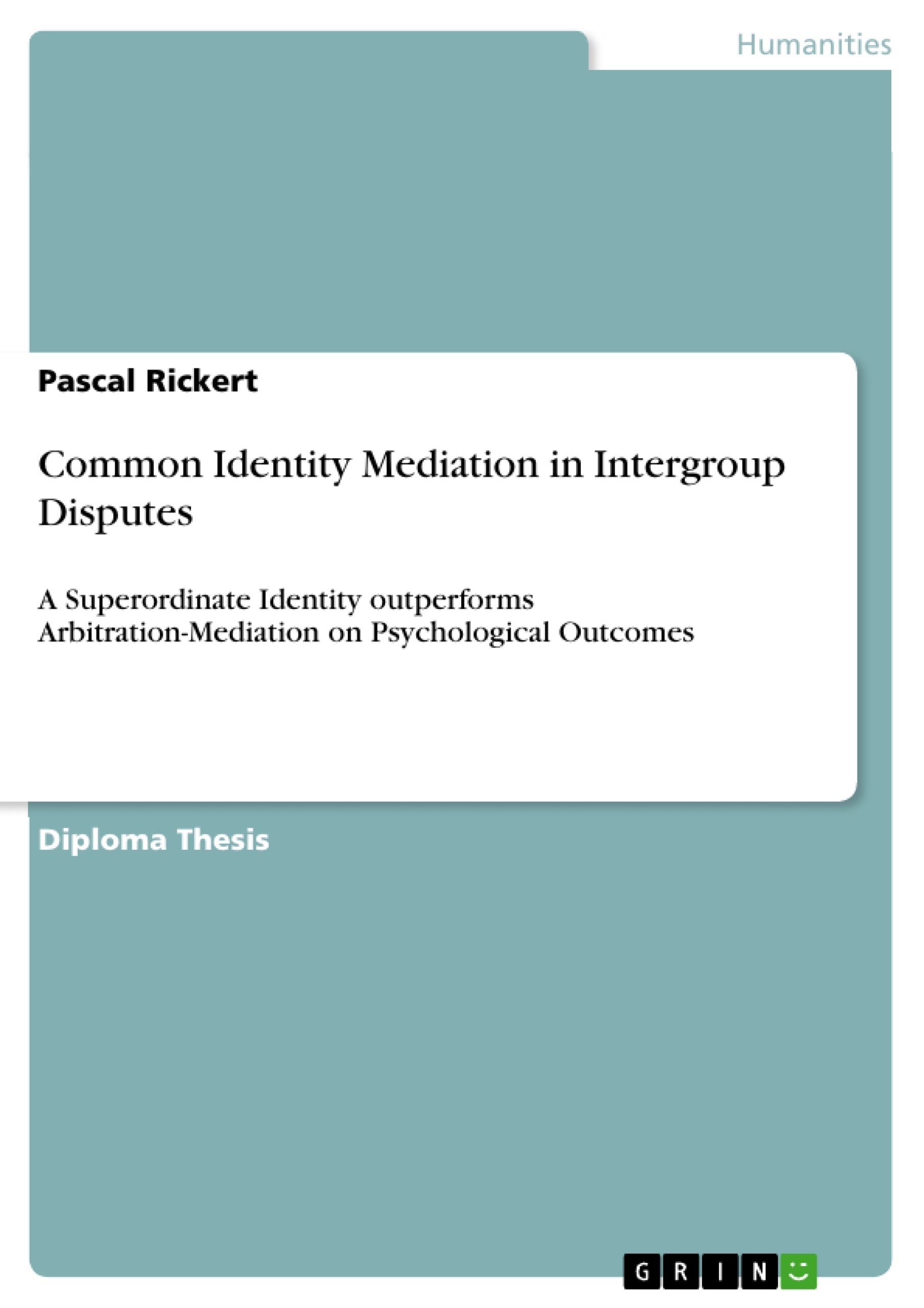The present research intends to explore the effectiveness of Common Identity Mediation (cf. Gaertner, Mann, Murell, & Dovidio, 1989), a third-party intervention procedure especially conducive to facilitate intergroup dispute resolution. We therefore compared Common Identity Mediation to another third-party procedure (i.e., Arbitration-Mediation; cf. McGillicuddy et al. 1987; Ross und Conlon 2000) and an intergroup control condition without third-party assistance. We used a face-to-face, distributive intergroup dispute paradigm including circumstances that elevate the risk for failed third-party interventions (e.g., high emotional involvement of disputants). Results indicate that Common Identity Mediation is as effective as Arbitration-Mediation in reducing the risk of partial impasses and to improve economic outcomes. In addition, Common Identity Mediation shows a slight advantage in boosting psychological outcomes such as feelings of connectivity, shared identity, judgments of counterparts and satisfaction with the arranged settlement. Findings are discussed in light of social identity theory, the Common Ingroup Identity Model, the Ingroup Projection Model and with respect to their practical implications for practitioners.
Keywords: inter-group conflict, negotiation, dispute resolution procedure, Common Identity Mediation, Arbitration-Mediation, Common Ingroup Identity Model, Ingroup Projection Model
Inhaltsverzeichnis (Table of Contents)
- Abstract
- Chapter 1: Introduction
- Chapter 2: Literature Review
Zielsetzung und Themenschwerpunkte (Objectives and Key Themes)
This research aims to evaluate the effectiveness of Common Identity Mediation (CIM) in resolving intergroup disputes, comparing it to Arbitration-Mediation and a control condition. The study investigates whether CIM can reduce impasses, improve economic outcomes, and enhance psychological outcomes such as feelings of connectivity and shared identity.
- Effectiveness of Common Identity Mediation
- Comparison of Common Identity Mediation with Arbitration-Mediation
- Impact on psychological outcomes (connectivity, shared identity, satisfaction)
- Role of social identity theory in intergroup dispute resolution
- Implications for dispute resolution practices
Zusammenfassung der Kapitel (Chapter Summaries)
Chapter 1: Introduction: This chapter sets the stage by illustrating the prevalence and cost of intergroup disputes, using the Lufthansa-UFO strike as a prime example. It highlights the need for effective dispute resolution procedures, especially third-party interventions like arbitration and mediation. The chapter introduces the concept of Common Identity Mediation (CIM) as a less-studied yet potentially valuable approach and positions CIM within the broader context of existing third-party intervention research, emphasizing the need to compare CIM's effectiveness to established methods like Arbitration-Mediation.
Chapter 2: Literature Review: This chapter delves into the theoretical underpinnings of intergroup conflict and the challenges of third-party interventions. It discusses social identity theory and its implications for negotiation dynamics, highlighting how intergroup bias can hinder successful dispute resolution. The chapter positions Common Identity Mediation within the framework of social identity theory and related models, explaining how CIM aims to mitigate the negative effects of intergroup bias by fostering a shared superordinate identity among disputants. The review also examines existing research on arbitration and mediation, and their hybrid forms, providing a context for the study's comparison of CIM to Arbitration-Mediation.
Schlüsselwörter (Keywords)
Intergroup conflict, negotiation, dispute resolution, Common Identity Mediation, Arbitration-Mediation, social identity theory, Common Ingroup Identity Model, Ingroup Projection Model, intergroup bias.
FAQ: Comprehensive Language Preview of Research on Common Identity Mediation
What is the main topic of this research preview?
This preview summarizes a research paper investigating the effectiveness of Common Identity Mediation (CIM) in resolving intergroup disputes. It compares CIM to Arbitration-Mediation and a control condition, analyzing its impact on economic and psychological outcomes.
What are the key objectives of the research?
The research aims to evaluate the effectiveness of CIM in resolving intergroup disputes, compare it to Arbitration-Mediation, and assess its impact on various outcomes. Specifically, it examines CIM's ability to reduce impasses, improve economic results, and enhance psychological outcomes like feelings of connectivity and shared identity. The role of social identity theory in intergroup dispute resolution is also explored.
What are the key themes explored in the research?
Key themes include the effectiveness of Common Identity Mediation, a comparison between CIM and Arbitration-Mediation, the impact on psychological outcomes (connectivity, shared identity, satisfaction), the role of social identity theory, and the implications for dispute resolution practices.
What is covered in Chapter 1: Introduction?
Chapter 1 introduces the prevalence and costs of intergroup disputes (using the Lufthansa-UFO strike as an example), highlighting the need for effective dispute resolution. It introduces Common Identity Mediation (CIM) and positions it within the context of existing third-party intervention research, emphasizing the need for comparison with established methods like Arbitration-Mediation.
What is covered in Chapter 2: Literature Review?
Chapter 2 explores the theoretical foundations of intergroup conflict and the challenges of third-party interventions. It discusses social identity theory and its impact on negotiation, showing how intergroup bias hinders dispute resolution. The chapter places CIM within the framework of social identity theory, explaining how it aims to mitigate intergroup bias. It also reviews existing research on arbitration and mediation, setting the stage for comparing CIM to Arbitration-Mediation.
What are the keywords associated with this research?
Keywords include: Intergroup conflict, negotiation, dispute resolution, Common Identity Mediation, Arbitration-Mediation, social identity theory, Common Ingroup Identity Model, Ingroup Projection Model, and intergroup bias.
What is the overall purpose of this document?
This document serves as a comprehensive preview of the research, providing a detailed overview of its contents, including the title, table of contents, objectives, key themes, chapter summaries, and keywords. It's intended for academic use, facilitating the analysis of themes within the research.
Where can I find more information about this research?
The full research paper would provide the complete details.
- Citar trabajo
- Pascal Rickert (Autor), 2013, Common Identity Mediation in Intergroup Disputes, Múnich, GRIN Verlag, https://www.grin.com/document/230089



